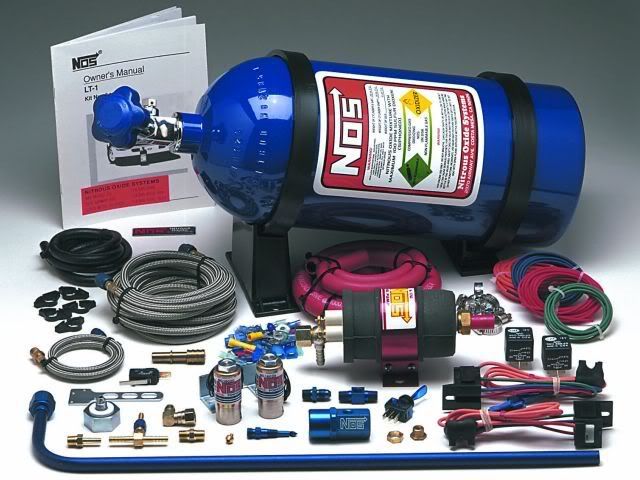 Dry single point nitrous injection systems have a single nozzle and one nitrous solenoid. They are also called single fogger systems. In this type of nitrous oxide set up, the nitrous is introduced to the engine from the solenoid through the single nozzle. These simple set ups will require additional fuel to keep the air fuel ratio at optimum levels. This can be accomplished by adding a fuel pressure regulator that increases fuel pressure to the injectors when the nitrous solenoid is activated.
Dry single point nitrous injection systems have a single nozzle and one nitrous solenoid. They are also called single fogger systems. In this type of nitrous oxide set up, the nitrous is introduced to the engine from the solenoid through the single nozzle. These simple set ups will require additional fuel to keep the air fuel ratio at optimum levels. This can be accomplished by adding a fuel pressure regulator that increases fuel pressure to the injectors when the nitrous solenoid is activated.A typical single point injection system can come it two varieties: wet or dry injection. The dry injection systems supply only the nitrous oxide to the system. Wet injection systems mix the nitrous with fuel before delivering it to the engine. The dry injection system may contain a solenoid, the nitrous jets, and the nitrous pressure reference fuel pressure regulator. To get the added extra fuel, these systems will clamp the return fuel lines under nitrous conditions, raising the fuel pressure at the injectors. This will provide the extra fuel needed to stay at the optimum mixture levels. The disadvantage of these systems is that you can only squeeze so much fuel out of the stock injectors and fuel pump, and as the fuel ratio leans out under heavy nitrous runs, you get an increased risk of premature detonation which, when coupled with nitrous oxide, can have some terrible results.
Wet single point injection systems use a fogging or "fogger" nozzle to mix the fuel and nitrous together before spraying it into the intake. These systems solve the problem of the dry single point systems not being able to provide enough fuel. Considering that modern intakes are designed to flow air and not liquid, it is important to mix the fuel and nitrous gas before the intake throttle body. Most tuners and mechanics suggest at least six inches before the throttle body to get a good mixture. Since this type of fogging system has its own fuel supply, it is not limited to the fuel pump's output.
Which one is better? That depends on how much nitrous oxide you intend to run through the system. Dry point injection is typically good for up to 50 horsepower shots because of the even fuel distribution from the injectors. A shot larger than this and you risk running lean, so the additional fuel is needed from a wet injection system. It is also a good idea to run a cooler grade spark plugs and at least 91 octane gas for these applications. Above 50 horsepower shots, and you may need to retard the timing by 2-4 degrees.
If you intend to blow the doors off the competition with a 75 shot or more of nitrous oxide, look into a direct port injection system. These nitrous oxide injection systems will be used specifically for race applications, and are not recommended for street use. These types of systems will be looked at in greater detail in our next segment.
For more great auto accessories visit Majestic Modifications Online!


